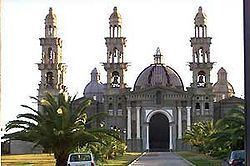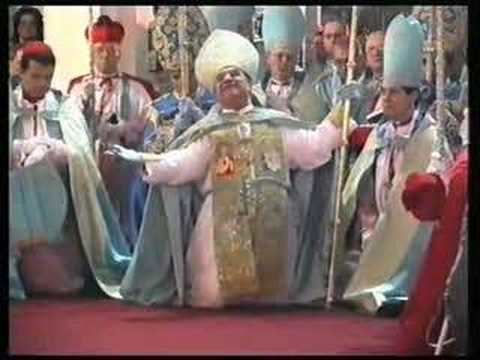Founded 1975 | ||
 | ||
Founder Clemente Domínguez y Gómez | ||
Palmarian catholic church
The Christian Palmarian Church of the Carmelites of the Holy Face (Spanish: Iglesia Cristiana Palmariana de los Carmelitas de la Santa Faz), commonly called the Palmarian Catholic Church (Iglesia Católica Palmariana), is a small schismatic Catholic church with an episcopal see in El Palmar de Troya, Spain.
Contents
- Palmarian catholic church
- Saints
- Origins
- Consecration of bishops
- Claim to the papacy
- Peter II
- Gregory XVIII
- Peter III
- Present day
- Popes
- Mount of Christ the King
- In film
- References

The church regards Pope Paul VI, whom they revere as a martyr, and his predecessors as true popes, but hold, on the grounds of claimed apparitions, that the Pope of Rome is excommunicated and that the position of the Holy See has, since 1978, been transferred to their See of El Palmar de Troya.

The Palmarian Catholic Church has had four pontiffs since its establishment. Clemente Domínguez y Gómez (Pope Gregory XVII) declared himself pope in 1978 until his death in 2005; Manuel Corral (Pope Peter II) succeeded Domínguez in 2005 and led the church until his death in 2011. Corral was succeeded by Ginés Jesús Hernández (Pope Gregory XVIII) in 2011. Hernández resigned in 2016 to marry and was succeeded by Joseph Odermatt (Pope Peter III) in 2016.

Saints

Saints canonized by the Palmarian church include Christopher Columbus, Francisco Franco, Francisco Jiménez de Cisneros, José Antonio Primo de Rivera, José Calvo Sotelo, Josemaría Escrivá, Adolf Hitler, Luis Carrero Blanco, and Pelagius of Asturias.
Origins
In March 1968, four Spanish schoolgirls (only known as Ana, Josefa, Rafaela and Ana María) stated they saw an apparition of the Virgin Mary by a little tree on a piece of farmland called La Alcaparrosa near Palmar de Troya. Many people came to witness the supposed apparitions, and a number of miracles similar to those alleged to have happened at Fátima, Garabandal and Međugorje were said to have occurred. The seers had many supporters, including priests. Several other people reported visions at the site, including Clemente Domínguez y Gómez, an insurance broker from Seville. He gradually became the "principal seer".
The original seers's visions were dismissed by the local bishop. They returned to their normal lives and allegedly said to wish to only forget the past and to have no connection with the Palmarian Church. Domínguez claimed that the Virgin Mary had given him instructions to rid the Catholic Church of "heresy and progressivism", and of Communism.
In 1975, Domínguez formed a new religious order, the Order of Carmelites of the Holy Face, which claimed to be "faithful to the holy Pope Paul VI". It claimed that Paul VI was detained in the Vatican by evil conspiring cardinals. The order was initially run by laymen, but supported sacramentally by priests from Spain, Portugal, and the United States.
Consecration of bishops
To be guaranteed access to the sacraments, Domínguez's group needed its own bishops. Domínguez wrote a letter to Marcel Lefebvre and asked him to consecrate him, but Lefebvre declined the offer and told them to contact a traditionally-minded Vietnamese bishop instead. In 1976, Swiss priest Maurice Revaz (who had taught Canon Law at the Society of Saint Pius X (SSPX) seminary in Ecône) persuaded the elderly Vietnamese Archbishop Ngo Dinh Thuc of the authenticity of the apparitions. Thuc was chosen because he was a papal legate. Accepting the mystical message of the seer-mystics, the Archbishop believed that he was called by the Virgin Mary to raise two of the order's members (Domínguez and a lawyer named Manuel Alonso Corral) and three of the priests associated with the group to the rank of bishop. Thuc also ordained some laymen to the priesthood.
Thuc acted without obtaining the mandatory authorisation from the Holy See, he and the five men he consecrated as bishops were subsequently excommunicated by Paul VI. Thuc subsequently cut his ties with the group and was reconciled with the Church authorities.
Claim to the papacy
Following the death of Paul VI in 1978, Domínguez claimed that he had been mystically crowned pope by Jesus Christ in a vision. He took the papal name Gregory XVII, and appointed his own cardinals. By these actions, the "Carmelites of the Holy Face" evolved into the Palmarian Catholic Church. Some Catholics previously associated with the Carmelites left the group as a result.
The popes of the Palmarian Church do not claim to be the titular bishop of Rome. Rather, they claim that Christ transferred the position of Patriarch of the West and Supreme Pontiff to the new episcopal see of El Palmar de Troya. This is a departure from traditional Catholic doctrine, which identifies the papacy with the bishop of Rome. Roman Catholic teaching also holds that personal revelations are not binding on the Church as a whole.
In his capacity as pope, Domínguez called the Roman Catholic Church a false church and declared Pope John Paul II excommunicated. Gregory XVII canonized Franco, Escrivá, and Columbus; and declared Paul VI a martyr saint.
Peter II
Domínguez died in March 2005, according to Palmarian sources, supposedly experiencing a vision during an Easter Liturgy. His successor as pope immediately declared Domínguez to be Pope Saint Gregory XVII the Very Great. Manuel Alonso Corral, named in 2000 by Domínguez as his successor, succeeded him as Peter II. There was no Palmarian conclave for this election.
Peter II made no claims to visions but stated that the Antichrist was born in the year 2000. Palmarian doctrine indicates that the Antichrist will mock Christ and imitate him by making a public appearance at age of 12, i.e. c. 2012, and begin his public life when he is 30 years old.
Peter II died on July 15, 2011 after a long illness.
Gregory XVIII
Peter II was succeeded by his Secretary of State, Hernández, who took the name Gregory XVIII. Gregory XVIII is a former member of the Spanish Military. Gregory XVIII resigned the papacy on April 22, 2016. Earlier known as a hardliner, towards the end of his papacy he made several church norms less strict.
Peter III
After the resignation of Gregory XVIII, a new pope was crowned in the Palmarian Church on April 23, 2016. As expected it was Odermatt, who was previously Gregory XVIII's Secretary of State. Odermatt adopted the papal name Peter III.
Present day
In a sermon held in August 2011, Gregory XVII said that the Palmarian Church had between 1,000 and 1,500 members, but in the following years many were excommunicated. In 2015 the number of bishops were probably down to about 30 and the number of nuns were around 30, too. According to Magnus Lundberg, "except for at the very beginning, most new members were children of Palmarian couples and not people coming from outside." As of 2005, 32 bishops remained out of 192 men who were consecrated as bishops between 1976–2005, according to Lundberg.
Since 1983 the Palmarian Church has drastically reformed its rites and its liturgy, which previously had been styled in the Tridentine form. The Palmarian liturgy was reduced to almost solely the Eucharistic words of consecration. The See of El Palmar de Troya has also declared the Real Presence of the Virgin Mary in the sacred host and the bodily assumption into heaven of St. Joseph to be dogmas of the Catholic faith. By 2000, they had their own Palmarian version of the Bible, revised by Domínguez on claimed prophetic authority and a product of the Second Palmarian Council, also known as the Palmarian. For these reasons and their strict rules allowing no communication with people outside of the faith, other Catholics consider the Palmarian Church to be heretical and cult followers.
The Archidonian Palmarian group (Archidona, Malaga, Spain) formed in 2000 was due to the expulsion of 16 cardinals and five nuns. They were expelled by Domínguez for diverse reasons. The predominant reason for the expulsions was due to Domínguez's belief that there was "a church within a church" planning to overthrow or assassinate him. One cardinal, Cyril María, was expelled due to the new edition of the Bible. The group in Archidona has since almost disbanded and there remains four or five. They presently call themselves "independent" Palmarian priests. They believe that the see of Peter is once again vacant.
Popes
Palmarian Catholics generally accept the conventional succession of Roman Catholic Popes up to Paul VI (r. 1963 – 1978) but reject the conventional succession after him.
Mount of Christ the King
The sect's walled compound, near the village of El Palmar de Troya, surrounds the Cathedral-Basilica of Our Crowned Mother of Palmar which contains the Palmarian popes' cathedra and at least 50 altars.
In film
The events around the foundation of the church are depicted in the 1986 Spanish film Manuel y Clemente.
